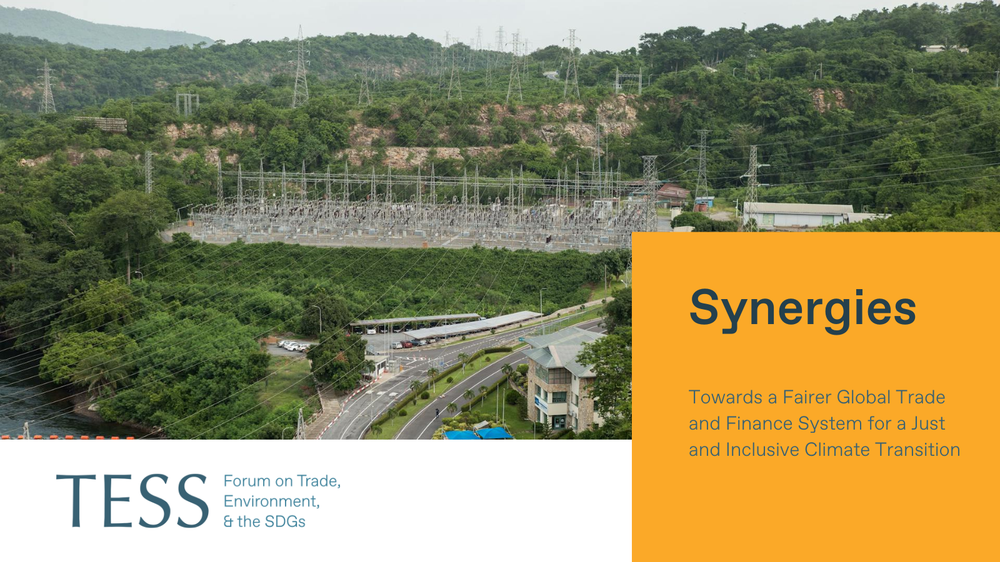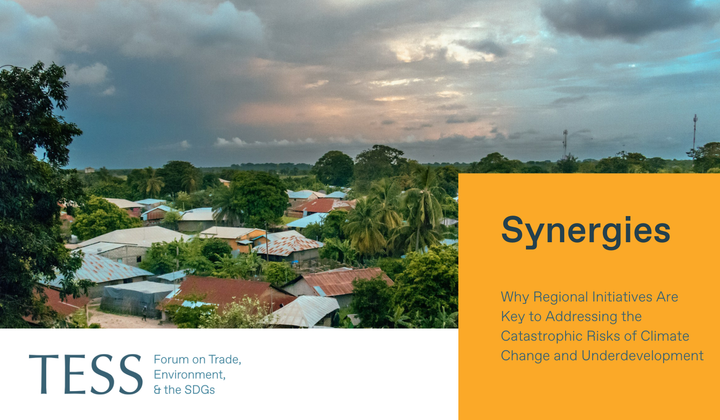The global transition to a low-carbon economy highlights stark inequalities, as developed countries surge with green industrialization while Africa and much of the Global South are hamstrung with structural and institutional barriers. This calls for crucial reforms in trade, finance, and technology transfer to ensure a truly just and inclusive climate transition.
This article is part of a Synergies series on climate and trade curated by TESS titled Addressing the Climate Crisis and Supporting Climate-Resilient Development: Where Can the Trading System Contribute? Any views and opinions expressed are those of the author(s) and do not necessarily reflect those of TESS or any of its partner organizations or funders.
-----

The world is experiencing a sweeping transition towards a low-carbon economy, driven by the mounting threat of catastrophic climate change and anchored in net-zero commitments and other regulations. This is changing the global competitive landscape as developed countries aggressively invest in green frontier technologies leveraging first mover advantage. This development has been buoyed by the emergence of green industrial policies in developed countries and large emerging economies—evident in the United States’ Inflation Reduction Act, China’s Made in China 2025, India’s National Solar Mission, and the European Union’s Green Industrial Deal and Net-Zero Industry Act.
In the Global South, green industrialization is gaining impetus in policy initiatives and discourse. Notably, the 2022 African Union Extraordinary Summit on Industrialization demonstrated a pledge towards the alignment of economic growth with international environmental agreements. However, implementation remains slow owing to uneven access to financing, fiscal constraints, and limitations on policy space influenced by conditionalities attached to foreign aid or bilateral investment treaties, among others. Consequently, the Global South—in particular Africa—continues to lag behind in the global green industrialization revolution.
Imbalanced Green Industrial Investments and Unfulfilled Commitments
Developed and emerging countries are leading in domestic R&D investments in green industry. Green technologies—measured through patent activity—remain highly concentrated, with about 85% of companies involved in green patent activity located in five countries—Japan, China, the United States Germany, and the Republic of Korea. Industrial firms from developing countries (excluding China) together hold a mere 2% of green patents. Likewise, the geographic deployment of renewable energy remains uneven; as of end 2023, Asia, Europe, and North America accounted for almost 85% of global installed capacity while Africa accounted for a mere 1.6%. Global investment in renewable power and fuels is strikingly unequal, with China, the United States, the European Union, and the United Kingdom dominating while Africa is at a very distant bottom.
This stark imbalance raises concerns about the principle of climate-resilient development and just transitions, which, by definition, should be fair and equitable for all. Granted, the Paris Agreement, acknowledges the unique circumstances of the Global South in Articles 2, 9, 10, and 11, underscoring the need to respond to climate change in the context of sustainable development and efforts to eradicate poverty, including by “making finance flows consistent with a pathway towards low greenhouse gas (GHG) emissions and climate-resilient development. ”There is also a pledge towards technology transfer and capacity building to developing countries to support the implementation of the Paris Agreement. Hitherto, pledges towards finance, technology transfer, and capacity building are largely unfulfilled.
Structural Barriers to Green Industrialization in Africa
Africa faces entrenched structural constraints embedded in its economies. Primarily, the low-value trap of commodity production and trade within value chains remains a key constraint. The continent remains dominated by the extraction of raw materials; 45% of Africa’s exports are raw materials whereas in Latin America, South Asia, and East Asia raw materials account for 31%, 8%, and 6% respectively. The share of manufactured goods in total exports for Africa is 34%, which is lower than other regions such as East Asia (83%), low- and middle-income countries excluding African countries (74%), South Asia (68%), Latin America (45%), and the world average (70%). Africa’s participation in global value chains is concerning as higher-income countries are more involved in supply chains. This hinders green industrialization by relegating African countries to the role of raw material suppliers, reinforcing dependency on external markets and hindering the development of resilient economies.
At the core of this challenge is inadequate infrastructure, which falls short of the intricate demands of processing plants. There is also a scarcity of local skilled labour necessitating substantial investment in education and training. Limited access to finance, especially for local entities, remains a major obstacle. Besides, unfavourable policy environments disincentivize investments in key value addition sectors. The lack of industrial and technological sophistication also keep a number of African economies at extreme systemic weaknesses, compelling them to export primary unprocessed products. Unreliable energy supply also remains a major impediment.
A Rigid Global Financial Architecture
The asymmetries and imbalances of the global financial architecture also structurally impede Africa, having failed to adapt to Africa’s unique climate finance needs. The multilateral finance system remains constrained by a limited capital base, fragmented mandates, and outdated instruments, thereby not responding to the unique needs of African countries. Access to climate finance and the cost of borrowing remain major bottlenecks in African countries, especially regarding green investments like renewable energy infrastructure.
For instance, the weighted average cost of capital for onshore wind power and solar photovoltaic between 2022 and 2024 was about 12% in developing economies compared to 4% in developed economies. This difference stems from factors like political and economic instability, currency risks, and underdeveloped financial markets, which collectively elevate the investment risk. Targeted policy and financial interventions such as legally binding offtake agreements, sovereign guarantees, and development finance risk and insurance can help lower the cost of capital. Ominously, the unpredictable pledge-based model under the United Nations Framework Convention on Climate Change (UNFCCC) offers non-concessional finance, trapping countries in unsustainable fiscal paths. Overall, the quality and quantity of finance delivered within and outside the UNFCCC mechanisms are inadequate.
The Rise of Unilateral Trade Policies
There is a rise in Global North unilateral trade policies—such as the European Union’s Carbon Border Adjustment Mechanism (CBAM)—which use environmental regulations to protect national interests at the expense of trading partners. These fees are justified as necessary tools to prevent carbon leakage, yet under the surface of their noble intentions lies a troubling contradiction. The imposition of such carbon fees on the products of developing countries that have historically contributed little to carbon emissions goes against the principle of common but differentiated responsibilities (CBDR), a cornerstone of international climate agreements. CBDR implies that while all nations must take climate action, the degree of responsibility should be shaped by historical contributions and current capabilities. Evidently, the measures have a demonstrably disproportionate impact on Africa, which lacks the technology and resources to adhere to stringent measures for its exports to the Global North. A study showed that across a range of models, CBAM could reduce Africa’s GDP by 0.91% and that its impact as a share of GDP would be higher for African countries.
A Call to Reform by Seizing the Moment
It goes without saying that countries in the Global South must make investments and increase their participation in green industries; failure to do so runs the risk of being trapped in new dependencies and remaining at the bottom of the value chain of green manufacturing. Nonetheless, the global transition to a low-carbon economy offers developing countries an opportunity to leapfrog technologically and alter their economies. This will require international trade cooperation to address some of the inherent structural challenges.
The World Trade Organization (WTO), though under strain, remains a pivotal forum for supporting the Global South in realizing a just transition. Developed countries must hold their end of the bargain regarding special and differential treatment (S&DT) as outlined in various agreements. While S&DT has historically been ineffective in practice due to its non-enforceability and lack of clarity, reforms can position it to become more effective. S&DT can play a crucial role in the transition to a low-carbon economy for developing countries through access to technical support to develop renewable energy technologies and infrastructure as well as some industrial policy measures for renewable energy equipment and technologies.
The WTO can also facilitate the use of flexibilities in the Agreement on Trade-Related Aspects of Intellectual Property Rights. This will allow developing countries to address climate change challenges through compulsory licensing and exceptions to patent rights. Such a move can facilitate access to and transfer of climate-friendly technologies enabling mitigation and adaptation efforts.
Towards a Fairer Global System
Developed economies that are applying unilateral policies against imports—“green protectionism”— should rather support a positive trade agenda to back developing countries in their mitigation efforts and adaptation development strategies. Systemic efforts to reduce domestic and global inequality could make more contributions to reducing carbon emissions. Therefore, these countries should pursue more transparent and science-based approaches.
In essence, the global transition to a low-carbon economy highlights stark inequalities, as developed countries surge with green industrialization while Africa and much of the Global South are hamstrung with structural and institutional barriers. This calls for crucial reforms in trade, finance, and technology transfer to ensure a truly just and inclusive climate transition.
----------
Shimukunku Manchishi is Senior Policy Officer, African Future Policies Hub.
-----
Synergies by TESS is a blog dedicated to promoting inclusive policy dialogue at the intersection of trade, environment, and sustainable development, drawing on perspectives from a range of experts from around the globe. The editor is Fabrice Lehmann.
Disclaimer
Any views and opinions expressed on Synergies are those of the author(s) and do not necessarily reflect those of TESS or any of its partner organizations or funders.
License
All of the content on Synergies is licensed under a Creative Commons Attribution-NonCommercial-ShareAlike 4.0 International (CC BY-NC-SA 4.0)
license. This means you are welcome to adapt, copy, and share it on your
platforms with attribution to the source and author(s), but not for
commercial purposes. You must also share it under the same CC BY-NC-SA
4.0 license.
If you would like to reuse any material published here or if you have any other question related to Synergies, send an email to fabrice.lehmann@graduateinstitute.ch.




